Abstract
In a case-control study of testis cancer 259 cases with testicular cancer, 238 controls treated at radiotherapy centres and 251 non-radiotherapy hospital in-patient controls were interviewed about some possible prenatal and familial risk factors for the tumour. For firstborn men, the risk of testis cancer increased significantly according to maternal age at the subject's birth, and this effect was most marked for seminoma. The association with maternal age was not apparent for cases other than firstborn. The risk of testis cancer was also significantly raised for men from small sibships and of early birth order. These results accord with the theory that raised maternal levels of available oestrogen during the early part of pregnancy are aetiological for testicular cancer in the son, although other explanations are possible; there is evidence that seminoma risk may particularly be affected.
Full text
PDF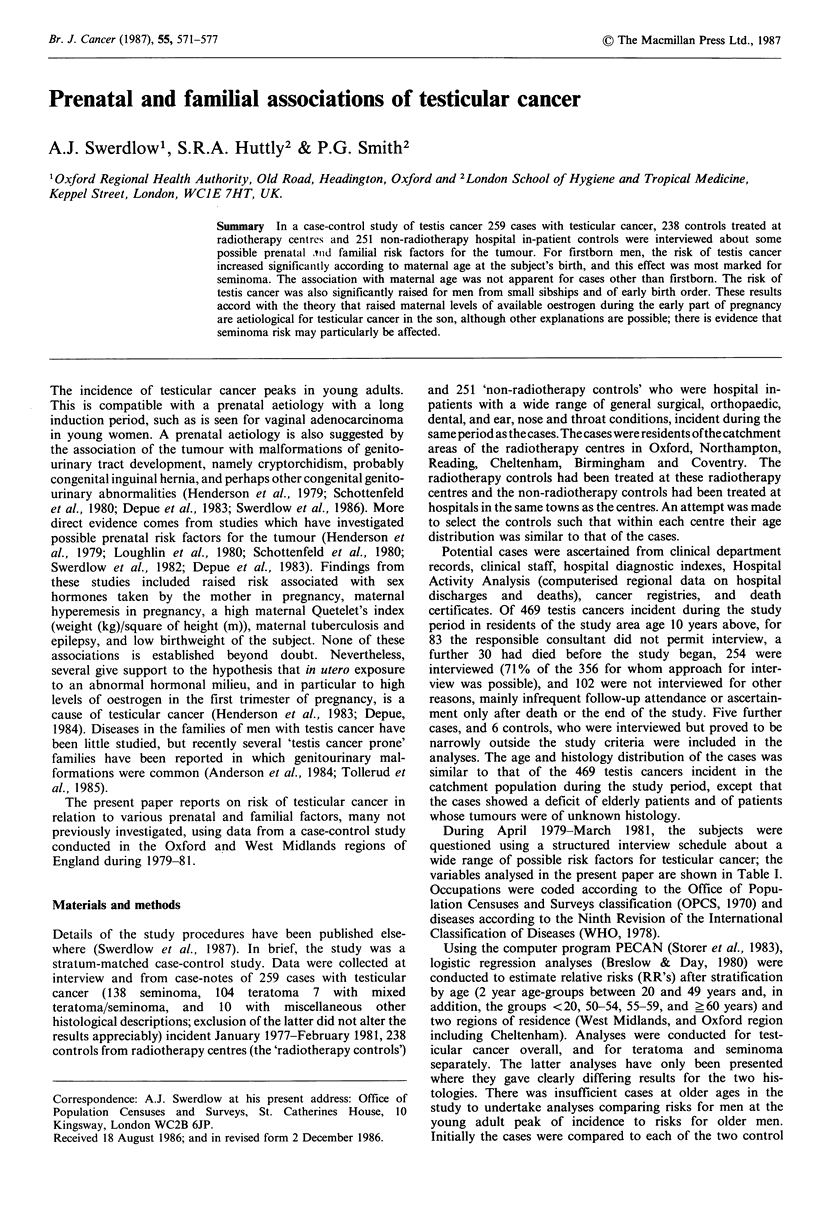
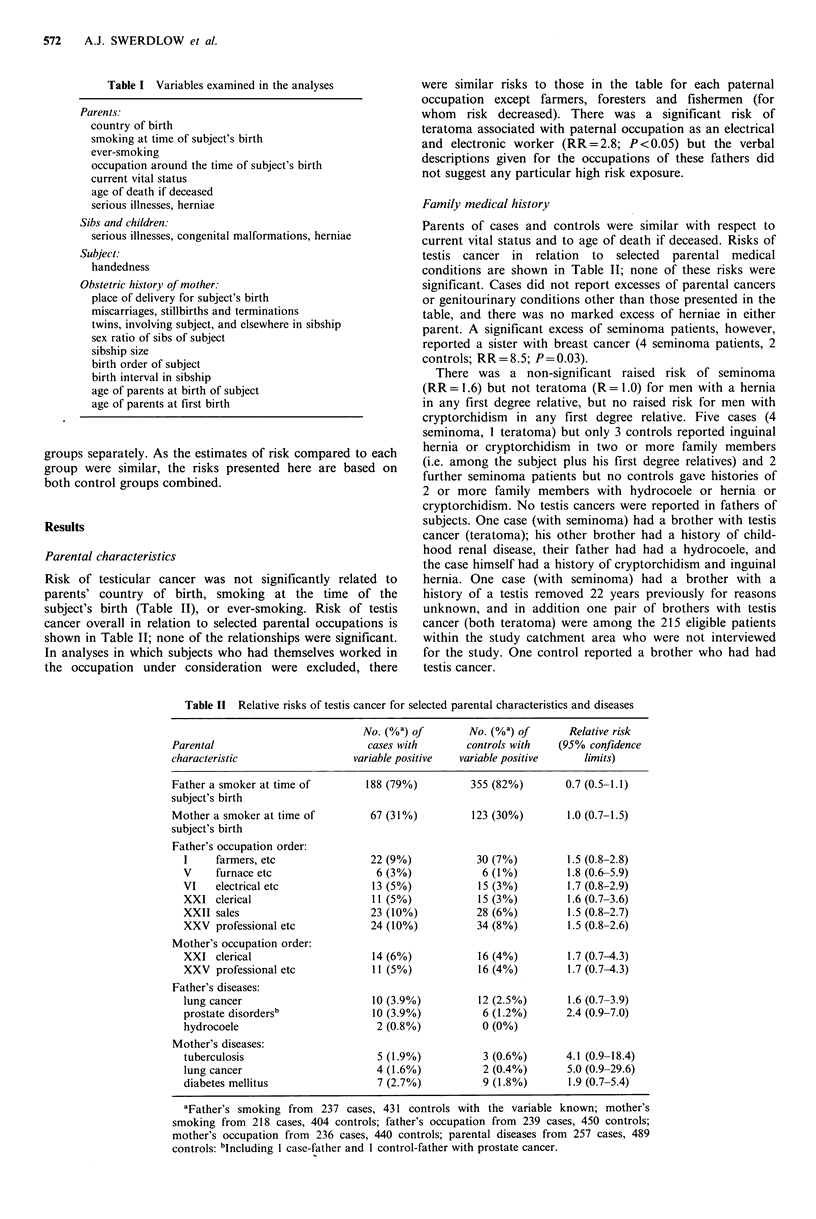
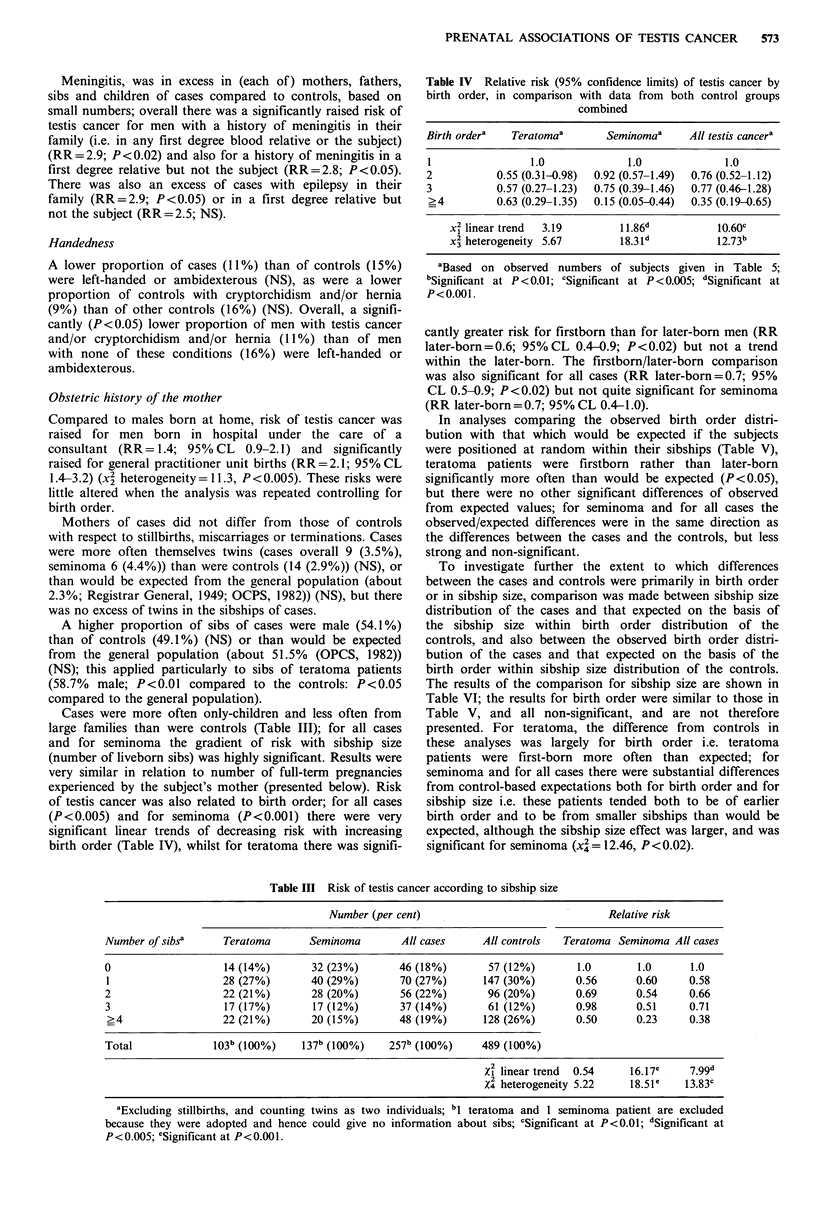
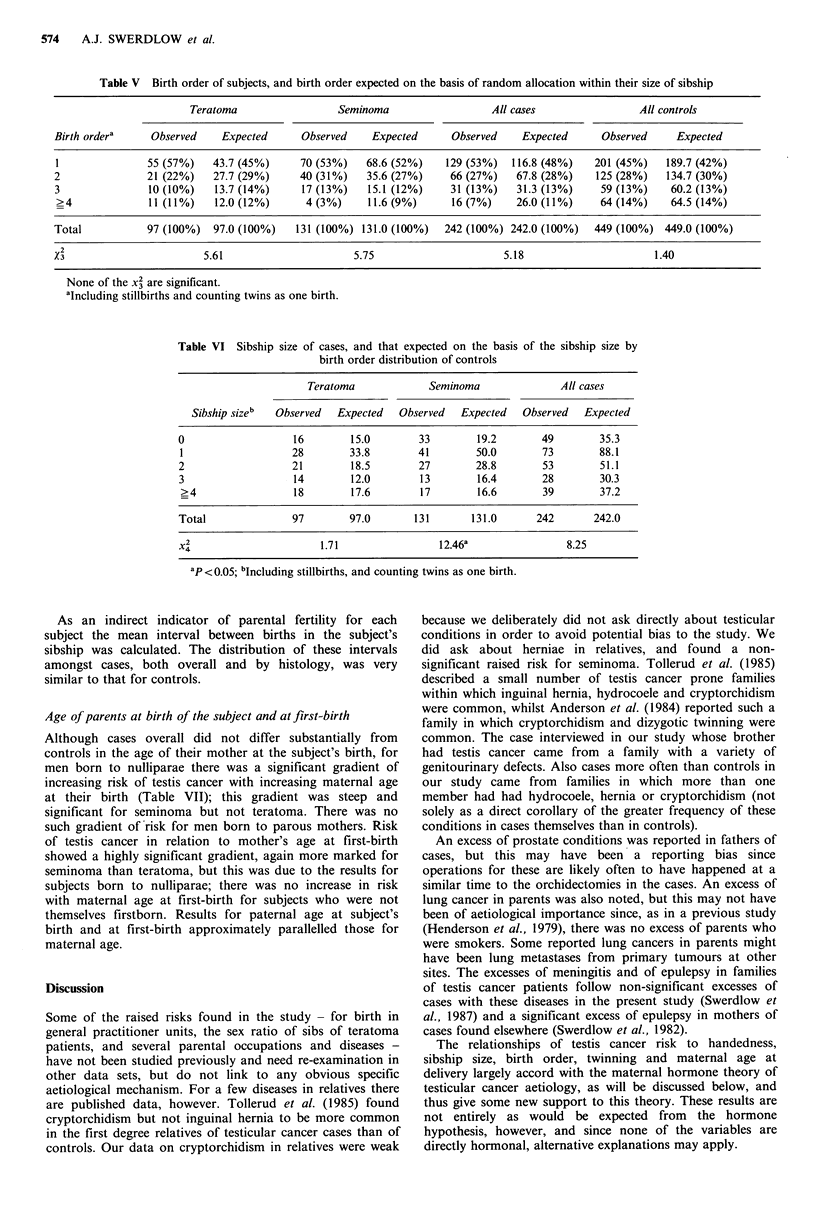
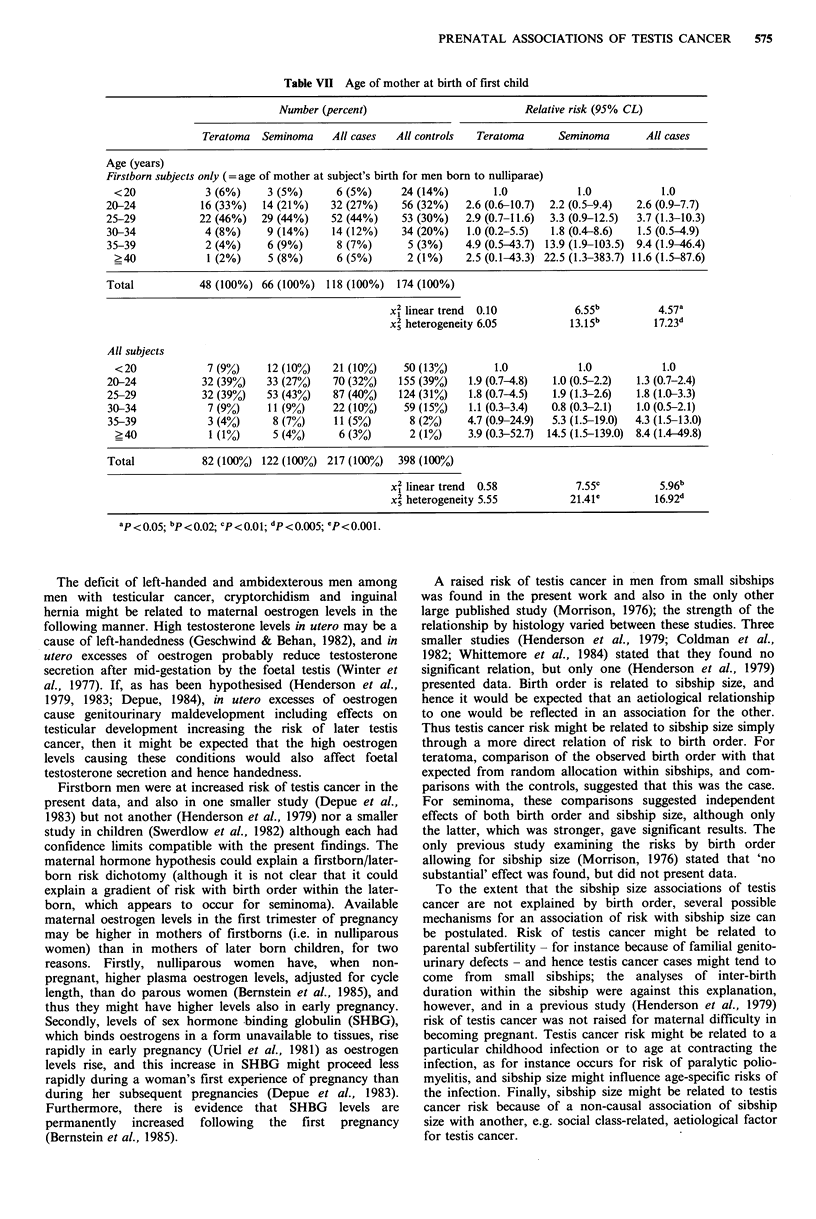
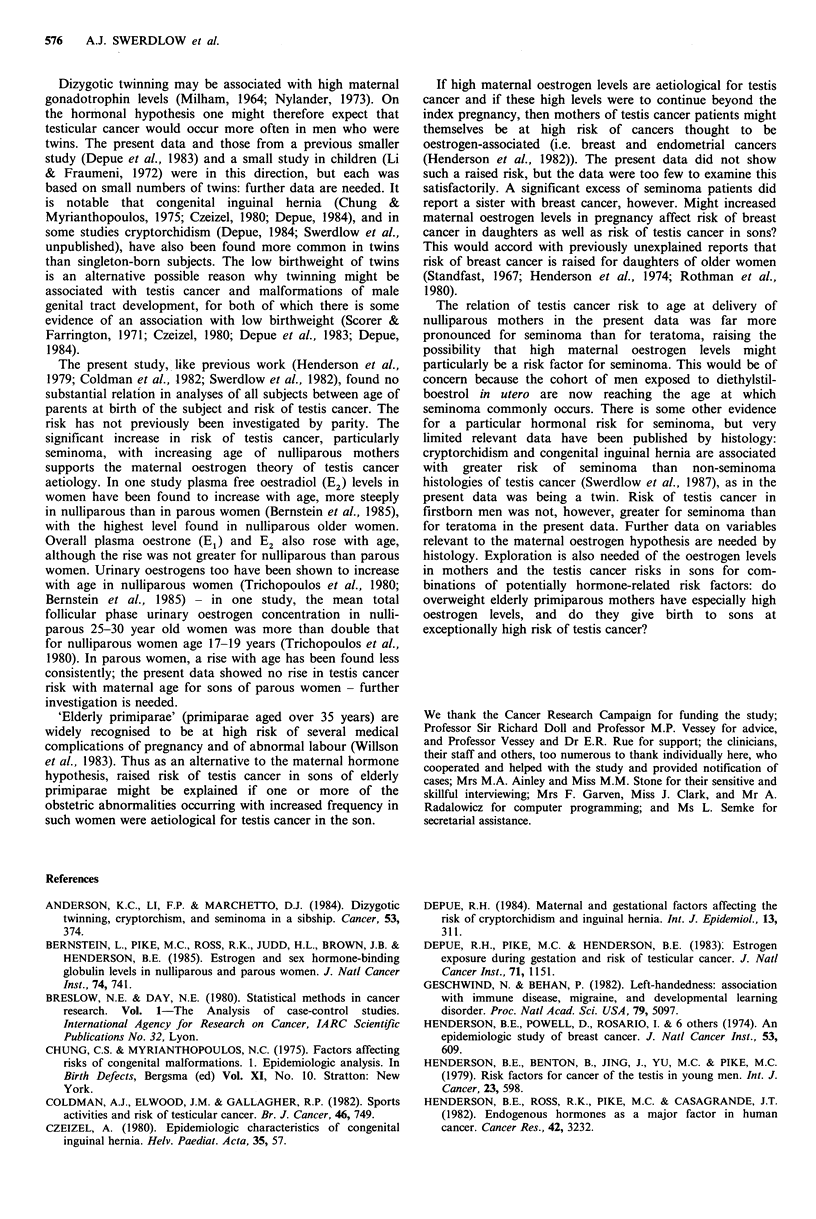
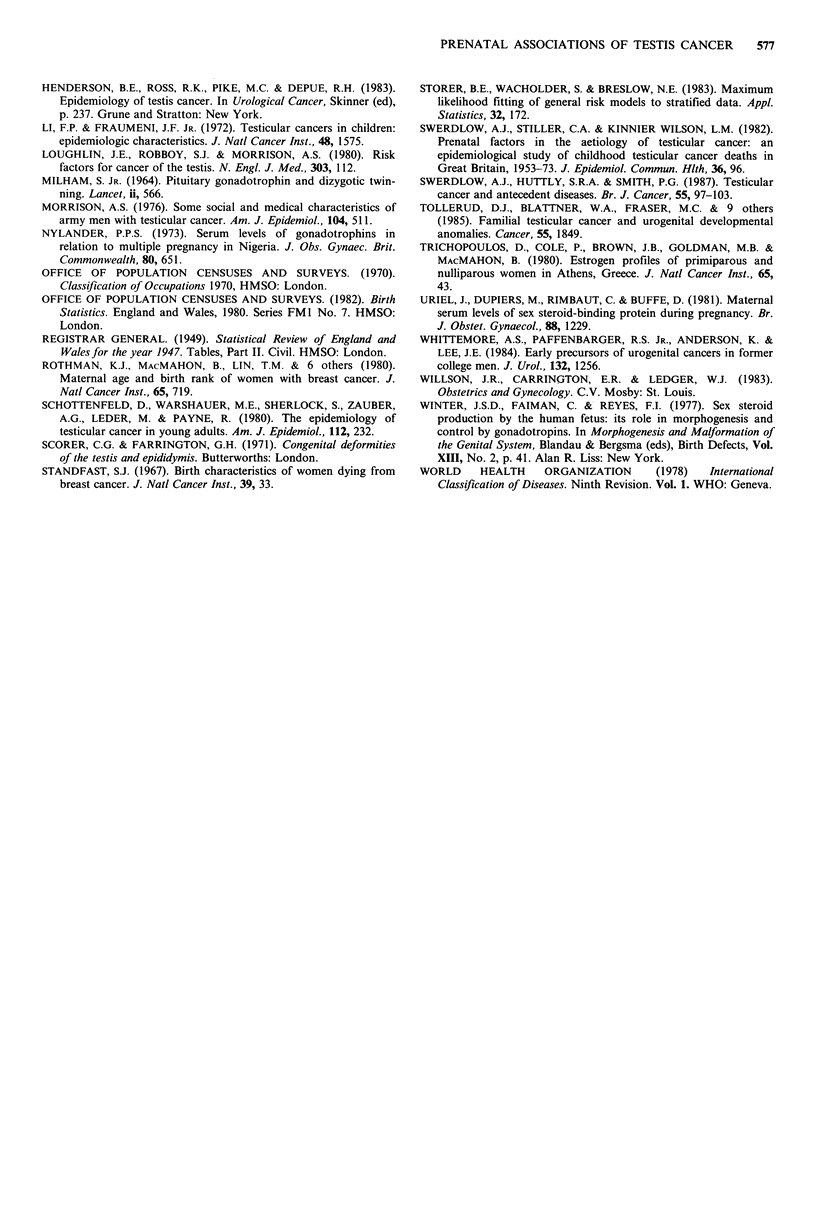
Selected References
These references are in PubMed. This may not be the complete list of references from this article.
- Anderson K. C., Li F. P., Marchetto D. J. Dizygotic twinning, cryptorchism, and seminoma in a sibship. Cancer. 1984 Jan 15;53(2):374–376. doi: 10.1002/1097-0142(19840115)53:2<374::aid-cncr2820530234>3.0.co;2-b. [DOI] [PubMed] [Google Scholar]
- Bernstein L., Pike M. C., Ross R. K., Judd H. L., Brown J. B., Henderson B. E. Estrogen and sex hormone-binding globulin levels in nulliparous and parous women. J Natl Cancer Inst. 1985 Apr;74(4):741–745. [PubMed] [Google Scholar]
- Coldman A. J., Elwood J. M., Gallagher R. P. Sports activities and risk of testicular cancer. Br J Cancer. 1982 Nov;46(5):749–756. doi: 10.1038/bjc.1982.267. [DOI] [PMC free article] [PubMed] [Google Scholar]
- Czeizel A. Epidemiologic characteristics of congenital inguinal hernia. Helv Paediatr Acta. 1980 Mar;35(1):57–67. [PubMed] [Google Scholar]
- Depue R. H. Maternal and gestational factors affecting the risk of cryptorchidism and inguinal hernia. Int J Epidemiol. 1984 Sep;13(3):311–318. doi: 10.1093/ije/13.3.311. [DOI] [PubMed] [Google Scholar]
- Depue R. H., Pike M. C., Henderson B. E. Estrogen exposure during gestation and risk of testicular cancer. J Natl Cancer Inst. 1983 Dec;71(6):1151–1155. [PubMed] [Google Scholar]
- Geschwind N., Behan P. Left-handedness: association with immune disease, migraine, and developmental learning disorder. Proc Natl Acad Sci U S A. 1982 Aug;79(16):5097–5100. doi: 10.1073/pnas.79.16.5097. [DOI] [PMC free article] [PubMed] [Google Scholar]
- Henderson B. E., Benton B., Jing J., Yu M. C., Pike M. C. Risk factors for cancer of the testis in young men. Int J Cancer. 1979 May 15;23(5):598–602. doi: 10.1002/ijc.2910230503. [DOI] [PubMed] [Google Scholar]
- Henderson B. E., Powell D., Rosario I., Keys C., Hanisch R., Young M., Casagrande J., Gerkins V., Pike M. C. An epidemiologic study of breast cancer. J Natl Cancer Inst. 1974 Sep;53(3):609–614. doi: 10.1093/jnci/53.3.609. [DOI] [PubMed] [Google Scholar]
- Henderson B. E., Ross R. K., Pike M. C., Casagrande J. T. Endogenous hormones as a major factor in human cancer. Cancer Res. 1982 Aug;42(8):3232–3239. [PubMed] [Google Scholar]
- Li F. P., Fraumeni J. F. Testicular cancers in children: epidemiologic characteristics. J Natl Cancer Inst. 1972 Jun;48(6):1575–1581. [PubMed] [Google Scholar]
- Loughlin J. E., Robboy S. J., Morrison A. S. Risk factors for cancer of the testis. N Engl J Med. 1980 Jul 10;303(2):112–113. doi: 10.1056/NEJM198007103030218. [DOI] [PubMed] [Google Scholar]
- MILHAM S., Jr PITUITARY GONADOTROPHIN AND DIZYGOTIC TWINNING. Lancet. 1964 Sep 12;2(7359):566–566. doi: 10.1016/s0140-6736(64)90626-9. [DOI] [PubMed] [Google Scholar]
- Morrison A. S. Some social and medical characteristics of Army men with testicular cancer. Am J Epidemiol. 1976 Nov;104(5):511–516. doi: 10.1093/oxfordjournals.aje.a112323. [DOI] [PubMed] [Google Scholar]
- Rothman K. J., MacMahon B., Lin T. M., Lowe C. R., Mirra A. P., Ravnihar B., Salber E. J., Trichopoulos D., Yuasa S. Maternal age and birth rank of women with breast cancer. J Natl Cancer Inst. 1980 Oct;65(4):719–722. doi: 10.1093/jnci/65.4.719. [DOI] [PubMed] [Google Scholar]
- Schottenfeld D., Warshauer M. E., Sherlock S., Zauber A. G., Leder M., Payne R. The epidemiology of testicular cancer in young adults. Am J Epidemiol. 1980 Aug;112(2):232–246. doi: 10.1093/oxfordjournals.aje.a112989. [DOI] [PubMed] [Google Scholar]
- Standfast S. J. Birth characteristics of women dying from breast cancer. J Natl Cancer Inst. 1967 Jul;39(1):33–42. [PubMed] [Google Scholar]
- Swerdlow A. J., Huttly S. R., Smith P. G. Testicular cancer and antecedent diseases. Br J Cancer. 1987 Jan;55(1):97–103. doi: 10.1038/bjc.1987.20. [DOI] [PMC free article] [PubMed] [Google Scholar]
- Tollerud D. J., Blattner W. A., Fraser M. C., Brown L. M., Pottern L., Shapiro E., Kirkemo A., Shawker T. H., Javadpour N., O'Connell K. Familial testicular cancer and urogenital developmental anomalies. Cancer. 1985 Apr 15;55(8):1849–1854. doi: 10.1002/1097-0142(19850415)55:8<1849::aid-cncr2820550834>3.0.co;2-1. [DOI] [PubMed] [Google Scholar]
- Trichopoulos D., Cole P., Brown J. B., Goldman M. B., MacMahon B. Estrogen profiles of primiparous and nulliparous women in Athens, Greece. J Natl Cancer Inst. 1980 Jul;65(1):43–46. [PubMed] [Google Scholar]
- Uriel J., Dupiers M., Rimbaut C., Buffe D. Maternal serum levels of sex steroid-binding protein during pregnancy. Br J Obstet Gynaecol. 1981 Dec;88(12):1229–1232. doi: 10.1111/j.1471-0528.1981.tb01202.x. [DOI] [PubMed] [Google Scholar]
- Whittemore A. S., Paffenbarger R. S., Jr, Anderson K., Lee J. E. Early precursors of urogenital cancers in former college men. J Urol. 1984 Dec;132(6):1256–1261. doi: 10.1016/s0022-5347(17)50118-4. [DOI] [PubMed] [Google Scholar]


